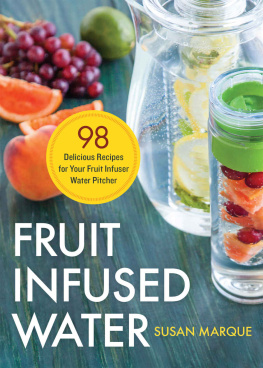AMERICAS
FOUNDING
FRUIT
The Cranberry in a New Environment
SUSAN PLAYFAIR
UNIVERSITY PRESS OF NEW ENGLAND
Hanover and London
University Press of New England
www.upne.com
2014 University Press of New England
All rights reserved
For permission to reproduce any of the material in this book, contact Permissions, University Press of New England, One Court Street, Suite 250, Lebanon NH 03766; or visit www.upne.com
Library of Congress Cataloging-in-Publication Data
Playfair, Susan R.
Americas founding fruit : the cranberry in a new environment / Susan Playfair.
pages cm.
Includes index.
ISBN 978-1-61168-631-9 (cloth : alk. paper)ISBN 978-1-61168-632-6 (pbk. : alk. paper)ISBN 978-1-61168-633-3 (ebook)
1. CranberriesUnited States. 2. CranberriesUnited StatesHistory. I. Title. II. Title: Cranberry in a new environment.
SB383.P53 2014
634'.760973dc23 2014013667
Illustration for the introduction, chapters 114, and the epilogue, 2013 Ji Liang. Illustration for For the Cook (Recipes), Drawing with Bowl, from an original illustration by Holly Hurd DiMauro, Mossy Pond Prints.
CONTENTS

INTRODUCTION
Without a farming population, a nation is never healthy in spirit. It strays into the landscape of illusion and climbs the hill of dreams. Yet only through an awareness of things as they are may we Raise a humane and tolerant order.
Henry Beston (Sheahan), The Great Realities, 2000
Our seasons are defined by the biological rhythms around us. We count the days until we can pick fresh blueberries in June, gather blackberries in July, catch striped bass and dig clams in August, swallow oysters in September, and harvest cranberries in October. But something is changing.
On Sunday, September 16, 2012, satellite images of Earth indicated the greatest melting of the Arctics summer sea ice recorded since 1979, the year when it first became possible to measure the degree of seasonal melt. The ice is melting because the land and sea around us are gradually warming and the plants, birds, and fish are either having to adapt or disappear.
This book is about one native fruit, the cranberry, how it is adapting, and what could be lost if it can still be grown in other countries, but not ours. I have chosen to write about the cultivation of a particularly American fruit; the men and women who grow and harvest it; how it is grown; its history, development, and health benefits; and how man and nature may be affecting the berrys long-term survival.
The cranberry is a metaphor for agriculture and a lesson to us about our interdependency with nature. The timing of its flowering is a cautionary reminder of the condition Rachel Carson imagined fifty years ago when she wrote a strange blight crept over the area and everything began to change. At the time she was referring to chemicals used for insect control, but the warning is as relevant today as then. Todays blight is CO2. The change is a gradual warming of the planet and the adjustments that plants, birds, fish, and ultimately humans need to make to survive.
Demographic data indicates that in 2012 more people worked as computer software engineers than as farmers in the United States. New apps may make our lives easier, but to survive we need to eat.
My great-grandfather owned and managed cranberry bogs, and I recall walking the bogs with him when I was three years old. Since then, in researching this book, I have walked bogs from Nantucket Island, Massachusetts, to Coos Bay, Oregon, and from Tomah, Wisconsin, to the Pine Barrens of New Jersey. I loved every minute of it. I hope this book helps introduce you to some of the people I met along the way and to a piece of our American heritage that we may be in danger of losing.
When I first began to gather material for this book, talking with the various men and women who grow and harvest cranberries, I asked if they were harvesting earlier as a result of a gradually warming planet. With few exceptions, each farmer replied that the berries have always ripened at the same time. Usually, the answer was that nothing had changed in the past hundred years, and that the harvest, depending on the variety, was always from the end of September into the beginning of November, except on the West Coast where cranberries enjoy a later and longer growing season. Only after completing much of the writing did I discover that, despite the farmers insistence that nothing has changed, I may have phrased the question incorrectly. I should have been asking if the plants flowered earlier in an especially warm year or, conversely, later in a cold year. The period when the plant is in flower is when the arrival of pollinators and other insects must be synchronized for both the pollinators and berry production. Flowering time for cranberries could shift the balance of nature in ways greater than just the survival of our iconic cranberry.
I was fortunate to meet two men who have kept records of cranberry flowering times for more than thirty years. Thanks to them, together with Richard Primack, Libby Ellwood, and Caroline Polgar of Boston University, I have been able to explore whether or not the cranberry might be flowering earlier, what that means for other species, and what might change when cranberry growers and the cranberry itself try to adapt to a changing climate.
On one level this book is about how farmers in a particular industry work. As readers, we cant very well understand the significance of losing the cranberry to other climates unless we understand how it is grown and who grows it. If growing conditions for a particular plant change, that plant can be grown somewhere else. For a single-crop farmer whose family may have grown cranberries or some other fruit in this country for four or five generations, the move to another country would not be easy and the loss of a native fruit that has been cultivated in this country for close to two hundred years would diminish our sense of who we are.
The cranberry industry may use the latest scanners, probes, and tracking devices to ensure the quality and safety of its products. Its members may employ windmills, solar panels, and computerized monitoring for efficiency and reduced energy consumption. It may sell its berries around the world, but it is still made up of a group of farmers dependent on the whims of nature; regulated by various local, state, and federal rulings; and controlled by the laws of supply and demand. As Tom Larrabee Sr., a grower on Nantucket Island, says as he looks out at Sankaty Head Lighthouse, There is nowhere else on earth where you could possibly even dream of having this kind of job. Unless cranberry growers and the larger population make some significant changes, the dream may not be a reality for future generations.


 INTRODUCTION
INTRODUCTION







